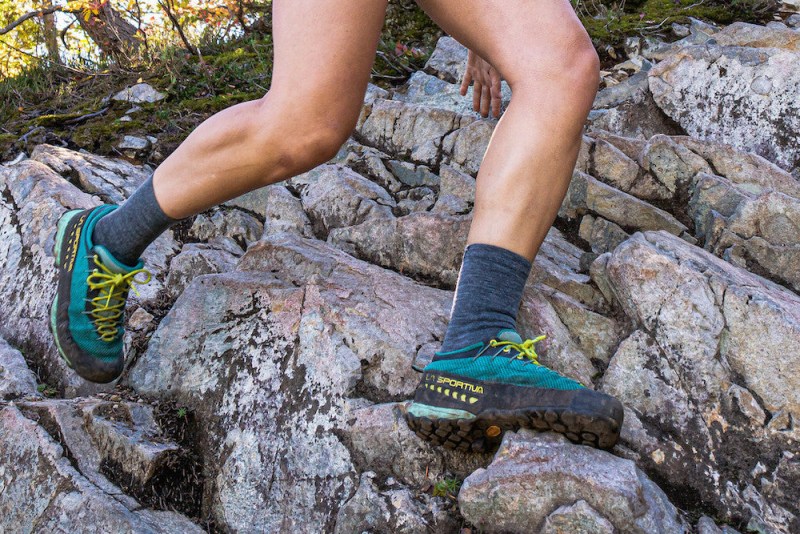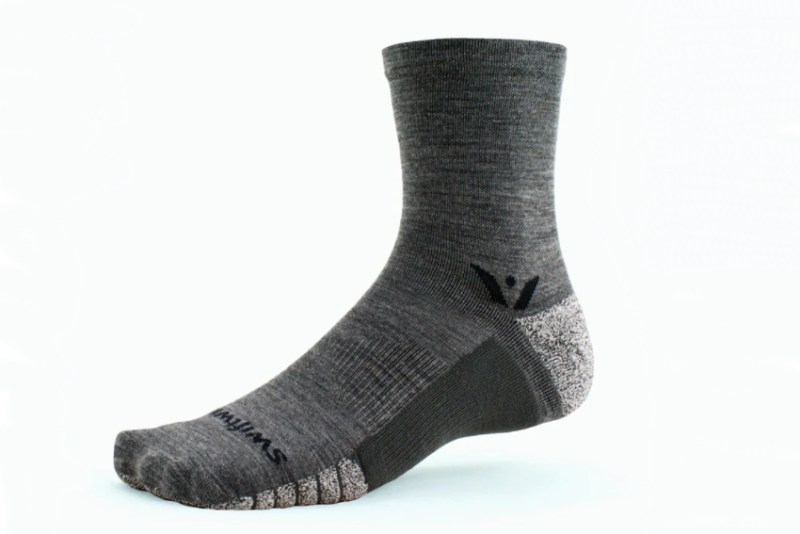There’s no shortage of options out there when it comes to performance socks, and nowadays you’ll find a sock on the market specifically designed for just about any activity. Hiking, running, trail running, cycling, golfing, competitive arm wrestling … you name it, someone is making a sock for it. That’s why I was keen on testing out the new Swiftwick Flite XT Trail, which Swiftwick claims is pound-for-pound the highest performing trail/hiking sock money can buy in 2022.
At its core, the Flite XT Trail’s proposal is simple: There’s no sock on the market that is this secure and stable inside your shoe. If you’re into a high-intensity hobby of some sort, the Flite XT Trail is the sock for you. After spending a month testing Swiftwick’s latest, I’ve gotta say I’m a fan. This sock delivers in a huge way for damn near anything you can throw at it.

What Is The Swiftwick Flite XT Trail Sock?
In short, the Flite XT Trail is the latest performance sock from Franklin, Tennessee-based company Swiftwick. Swiftwick is known for their high-end athletic socks, and if you’re a runner, hiker, or cyclist, chances are you’ve owned a pair or two yourself or seen some of their stuff at your local outfitter.
The folks at Swiftwick have loaded the Flite XT Trail with a laundry list of technical features, performance fibers, and proprietary technologies, and claim that this is “the most technologically advanced sock ever developed” by their brand or by anyone else for that matter. Naturally, I was interested in putting that claim to the test, so I spent the last month in a pair of their new flagship stockings to see what all the fuss was about.

How The Swiftwick Flite XT Trail Works
Swiftwick designed the Flite XT Trail as a “jack of all trades” performance sock for any outdoor activity requiring maximum support and stability. These socks combine the highlights of the brand’s other models (like the seamless toe box and excellent arch support) with a proprietary fiber technology called “GripDry” that’s designed to make the sock as grippy and secure as possible underfoot.
Any active sock worth its asking price, whether it’s for running, hiking, cycling, or general fitness, is judged by its ability to securely fit your foot (without being overly tight) to minimize friction while also providing a buffer between your skin and shoe to prevent blisters, hot spots, and general discomfort. The Flite XT Trail’s GripDry technology ups the ante on that front by also maximizing your sock’s ability to grip the insole of your shoe, theoretically reducing slip and friction that much more.
This “gripping” action is designed to make the Flite XT Trail the ideal performance sock for any activity involving lots of quick directional changes and stop-and-go movements that cause your feet to slide and squirm inside your shoe. It’s primarily focused on trail running and hiking, but it’s also a good fit for HIIT training and cardio-heavy workouts, and is a good pick for court sports like basketball and tennis.

Standout Features of the Flite XT Trail
To test the Swiftwick Flite XT Trail, I took a pair along for the ride on all my typical high-intensity activities. I spent time running trails and pavement, hiking, cycling, and mountain biking to get a good feel for all of its potential applications. My goal was to test all of the sock’s standout features and technologies as claimed by Swiftwick. For the Flite XT Trail, the main features were as follows:
- GripDry fiber: Swiftwick’s proprietary new fiber, which is employed in the forefoot and heel to increase the sock’s gripping power by increasing its surface area to improve gripping force.
- Y-shaped heel: The heel of the Flite XT Trail uses a y-shaped section of fabric to make a snug fit at the heel to prevent slipping/bunching while adding support during abrupt movements
- Olefin footbed: Swiftwick designed the Flite XT Trail with a 100% Olefin (polypropylene) footbed to maximize moisture-wicking, resist abrasion, and promote faster drying.
What I Liked About the Swiftwick Flite XT Trail
After a month of activity and several trips through the washer, here’s what Swiftwick got right with the Flite XT Trail:
- They’ve got a great comfort to performance ratio: While the ideal cushion/compression ratio of any performance sock is largely up to personal preference (and the type of activity you’re doing), I found the Flite XT Trail to be a Goldilocks compromise between the two. I particularly enjoyed them for trail running, as they feel like a 50/50 split between a medium/light cushion hiking sock and a compression-heavy performance runner. Swiftwick put moderate compression in the areas I really wanted it (specifically around the ankle and arch band) without overdoing it and feeling constrictive.
- GripDry works: Stability was Swiftwick’s top priority with the Flite XT Trail, and they hit that nail on the head. I tested the Flite XT Trail back to back with several of my usual go-to running and hiking socks including full synthetic and merino-intensive models, and you can really feel the difference when you pick up the pace or tackle elevation changes.
- They’re super versatile: One of my favorite parts about the Flite XT Trail was that you could get away with pretty much anything in them. They’re well ventilated and light enough to wear on a bike, but you can also push them hard out on the trail without fear of hot spots. Swiftwick’s seamless toe box is particularly good in that regard, as they play nice in a variety of footwear from snug clipless cycle shoes to trail runners with a roomier foot box.

Drawbacks Of The Flite XT Trail
Overall I was very impressed with the quality and performance of the Flite XT Trail. If you’re considering a pair yourself though, here are a few drawbacks to keep in mind.
- They’re not the best fit for chunky hiking boots: Versatility was a highlight of the Flite XT Trail, but they’re not my first choice for hiking in heavy boots. I prefer a little more cushioning in robust footwear, especially at the toes and on the sides of the foot. 76% of the materials in the Flite XT Trail are synthetic, and I typically prefer something that’s at least 50% merino for long-distance backpacking duty in traditional boots. They worked great in lighter boots like my Danner Mountain 600, but I’d go with something more traditional in a burly backpacking boot.
- They’re expensive: I prefer my outdoor socks (particularly trail runners) to sit well above the ankle, and at $27 a pair, the Swiftwick Flite XT Trail Five (the taller of the two sizes) is one of the spendier performance socks out there. Granted they’re not a far cry from other high-end models from brands like Smartwool, but if a general-purpose running or hiking sock is what you’re after, there are less expensive options out there.
- You’ll want to wash them after each wear: Yeah I know it sounds gross, but I’m not the only runner/hiker/biker out there that likes to put two (or more) wears on their socks between washes. Socks with a higher merino content are naturally more odor-resistant, so the 24% merino blend in the Flite XT Trail means you’ll probably want to wash them after each outing.
FAQs for the Swiftwick Flite XT Trail
The Swiftwick Flite XT Trail just launched this month, so customer reviews/impressions are slim to none. If you’re considering trying a pair yourself, here are some of the internet’s most common questions about the Flite XT Trail.
What Is the Fabric Blend for the Flite XT Trail?
The Flite XT Trail is primarily made from synthetic materials, using the following blend of fabrics: 38% nylon, 22% olefin, 13% polyester, and 3% spandex. You also get a decent amount of merino in the mix at 24% wool, which gives them a good blend of durability, comfort, and compression.
What Size Should I Get in Swiftwick Socks?
Swiftwick makes the Flite XT Trail in four sizes for men: Small, medium, large, and extra-large. These are “true to fit” so most men will fall between a large (for shoe sizes between 10-12) and an extra-large (between 12 1/2 and 15). Small socks are for shoe sizes between 3-5 1/2, while medium is recommended for sizes 6-9 1/2.
How Should I Wash/Dry the Flite XT Trail?
Swiftwick recommends washing all their socks with a cold machine wash, and drying them on a tumble-low setting. I prefer not to put socks with any amount of wool in the dryer on any cycle. Personally, I recommend just hanging them up after washing so you’re not leaving anything up to chance in the dryer.
Should You Buy the New Flite XT Trail Socks?
If you’re looking for a high-performance, high-tech sock that’s comfortable for just about any outdoor activity you can throw at it, I think the Flite XT Trail is well worth the money. Swiftwick’s GripDry fiber makes a noticeable improvement in overall stability and virtually eliminates any “slippery” feeling I often get from synthetic-heavy socks. If your activities of choice can benefit from some added staying-power, the Flite XT Trail is worth buying. The ability to have one sock in your quiver that works well for all your active hobbies is pretty sweet — just make sure they don’t skip any laundry days.




